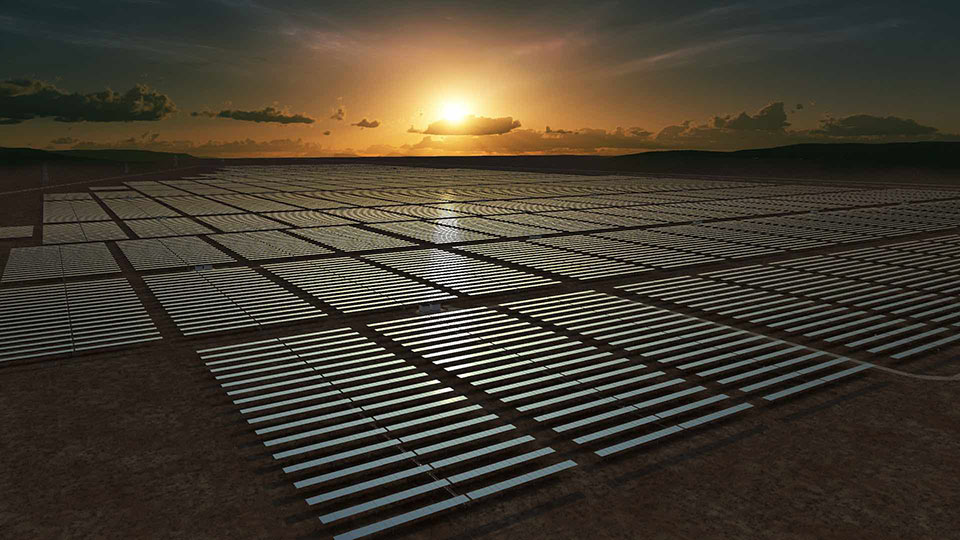
Solar Energy: The Beginning of a Revolution
Share this story!
Solar energy is booming. With an increase in supply as well as a decrease in cost, solar energy is now a real option for millions of people looking to sever ties with conventional energy. Over the last 40 years, the price of solar energy has decreased by 99.6 percent, from over $ 100 per watt in 1976 to just over 30 cents in 2017, and prices continue to fall. The real progress has been made in the last decade: between 2009 and 2017 the price fell by 80 percent.
Welcome to the solar energy revolution.
Sweden’s Solar Solution
In Sweden, solar energy accounted for a modest two-tenths of a percent of total electricity generation according to the latest statistics from 2017, but the potential for a larger workload is there. The Swedish Energy Agency estimates that the share of total electricity generation may increase to 14 percent by 2040.
About twenty thousand of Sweden’s two million homes have solar cells on their roofs and a total of roughly one million homes are estimated to have the necessary roof conditions needed to house solar cells. In addition, it is increasingly common for commercial properties to be installed with solar panels on the roofs and increasingly large facilities are being built.
In 2018, Sweden’s largest solar cell plant was installed at Säve airfield just north of Gothenburg. It has a capacity of 5.5 megawatts, sitting on around 11 hectares of land — almost twice the size of the former record holder Solsidan in Varberg. The plant is expected to deliver at least 5.5 megawatt hours per year. Installation of the twenty thousand solar panels was completed in just three months. No type of energy is able to be resourced and delivered as quickly as solar power is. Göteborgs Energi, which operates the plant, aims to build solar parks holding a capacity of 10 megawatts each by 2020.
In Sweden, a number of companies have become devoted to solar energy. The latest is the global brand Ikea, which will start selling solar cells for installation primarily on residential roofs in Sweden. SolTech Energy is another example of a Swedish company growing in solar energy. They mainly focus on integrated and aesthetically pleasing solar panels which replace conventional roofing tiles, essentially making them a part of the structure of the home.
Solar cells globally
Solar energy is now commercially and economically viable with zero government support in many markets around the world. From the small market share it held in the early 2000s to the sweeping advancements being made today, solar cells are now the fastest growing energy source globally. China is by far the largest producer of both solar technology and solar in the world currently.
The global development potential is enormous. In 2018, 453.5 terawatt hours were generated via solar energy. About 100 gigawatts per year are installed — the equivalent to about 100 large nuclear power plants.
Three generations of solar cells
The discovery of solar powered electricity was made as early as the 19th century — however, it took until the 1950s before the first solar cell (made of silicon) was built, and it has since been developed for three generations.
Generation One: Crystalline silicon solar cells
Crystalline silicon solar cells are the most common type of solar cell we see today and belong to the first generation. It is named after the structure of the silicon atoms of the solar cells, which are arranged like crystals. This type of solar cell is adversely affected by heat, which means that they provide less power as they get hotter. This is an advantage for the Swedish climate, where silicon solar cells can function effectively thanks to the cooler temperature.
This type of solar cell has two variants: monocrystalline and polycrystalline — where the former is the most common. Given that silicon is a readily available resource across the planet, the clear disadvantage is that a lot of energy is required to produce these cells. Crystalline silicon solar cells have a slightly higher efficiency than the next generation of solar energy but are also more expensive.
Generation Two: Thin-film solar cells
Thin-film solar cells belong to the second generation of solar cells and have a lower material cost than crystalline silicon solar cells. Heat does not affect generation two as badly as Crystalline Silicon variants, and Thin Film cells work slightly better than generation one counterparts under diffused light — such as when the sun is obscured by overcast conditions.
An example of thin-film solar cells is CIGS, which is comprised of copper, indium, gallium, and selenium. The best thin-film solar cells currently are manufactured from gallium arsenide and have an efficiency of about 28 percent. They are complex and expensive to manufacture and are therefore mainly used for solar panels in space.
Roughly 50 researchers at Uppsala University and the Ångström Laboratory are working to set two different world records in efficiency for solar cells.
The research group participates in the EU project Arcigs, which brings together 13 different parties from business and academia backgrounds across five different countries. The project, started in 2016, was granted a total of 4.5 million euros over three years and will conclude in 2019.
The first goal of Arcigs is to reach an efficiency of 23 percent with CIGS solar cells. The world record currently stands at 22.6 percent. The research team will try to reach the goal by making the CIGS layer (the part which absorbs light) much thinner. This layer is usually between 1.5 and two micrometers thick, but researchers want to reduce the thickness to about a quarter of that — 500 nanometers. This would make it possible to manufacture solar cells both faster and cheaper.
Generation Three: Perovskite and Gretzels solar cells
The second goal of the Ångström Laboratory is to use perovskite, an experimental solar cell which has been developed at a tremendous rate in a short amount of time. In just five years, the efficiency of this type of solar cell has increased by about 20 percent. This rapid development is mainly due to the fact that perovskite cells are cheap and easy to manufacture.
Perovskite has a number of very suitable properties for solar cells. The material absorbs light efficiently, making it possible to have layers that are up to 100x thinner than silicon solar cells. The world record for generation three efficiency is 22.1 percent.
Even though this type of solar cell is both cheaper and more efficient, the clear disadvantage is its shorter life span. But scientists are close to discovering methods which give these solar cells a life span three times greater than they currently have.
Grate cell solar cells (Gretzels solar cells) are a technology that is based on three key components: titanium oxide, a light absorbing dye and an electrolyte. The end result attempts to mimic the natural process of photosynthesis. The production of Grätzels solar cells is very simple — meaning that they can be produced at a fraction of the cost of silicon solar cells. Another advantage is their increased efficiency: Grate cells function at an acceptable efficiency percentage when natural light is dim; conditions are cloudy or foggy; or when the sun shines obliquely (at a bad angle) towards the solar cell. These are conditions which render silicon cells nearly unusable.
Examples of advanced innovation in solar tech
Svenska Exeger is far ahead in the development of solar technology: the company can build solar cells which incorporate logos and other designs to be part of the solar cell. Exeger makes designs specifically for customers who provide blueprints for what they need. The cells are flexible and can, for example, be integrated into headphones or tablets.
Nanowires, sitting at 1/1000 of a strand of hair, is another technology being researched to advance solar cells. Halmstad University has succeeded in creating high-quality layer structures at the nano level. This technology can make it possible to develop solar cells that are far more energy-efficient than today’s model.
New technology also makes it possible to build completely transparent solar panels, which can be integrated into homes via ordinary windows but also in mobile units and cars. Michigan State University is researching a solar technology that absorbs infrared and ultraviolet light — wavelengths which are not visible to the naked eye.
In addition to generating energy in seemingly ordinary windows, solar storage technology is also being developed. Molecular Solar Thermal, or MOST, is a system being developed that enables the storage of solar energy in a liquid medium — where the energy can later be released as heat. The technology can be applied in a transparent film which would make it possible, for example, to use it on windows inside a home.
Additional developments
- Epishine is a Swedish company that produces organic solar cells. In phase one, small solar cells will be optimized to replace batteries. The end goal is to integrate solar cells into both residential and commercial buildings.
- Swedish Algae Factory is developing a process and technology for growing silica algae and extracting its nanoporous shells. They have a pilot plant for growing silica algae on-site in Kungshamn and have started selling the nanoporous shell. Full-Scale algal cultivation is planned for 2020. In the longer term, the nanoporous shell will contribute to more efficient solar cells. Today it is used as a cleanser and moisturizer in the skincare industry. Early research also shows that this material can play a significant role in solar energy battery development. An algal silica-shell-based anode has the potential to increase the storage capacity of the anode in a battery and as a result, the charging capacity.
- Researchers have also devised a solution that reaches two goals in one fell swoop: a solar cell system which generates electricity and purifies water simultaneously. While the solar cells harvest sunlight and convert it into electricity, the heat from the solar panels is used to evaporate water. The evaporated water passes through membranes that filter out salt and other impurities and the pure water condenses on the other side. According to the researchers, this system does not affect the production of electricity.
In summary, intensive research in solar cells is ongoing and many expect cost reductions will continue, but also that the development of solar hardware makes it possible to integrate solar cells into a vast number of materials and surfaces and into completely new solutions.
Concentrated Solar Power
CSP, or Concentrated Solar Power, is an effective method for both capturing and storing solar energy. A cutting edge type of plant, known as Noor 3 in Morocco, consists of thousands of heliostats, or mirrors, that reflect sunlight against a tower in the center of the plant. In the tower, a salt-based-liquid medium is heated by the directed solar power to just over 550 degrees. The liquid is then pumped into a steam turbine which drives the generator. But the liquid can also be stored in an insulated tank which allows the solar energy to be stored for seven to eight hours — enough time to be used overnight.
This so-called thermal solar power differs from ordinary solar cells. It requires very large amounts of direct sunlight and is therefore particularly suitable desert areas. The storage capability makes this technology very interesting.
In summary, an enormous amount of research and innovation in the solar field is underway. A large part of our future energy needs will be covered by our nearest star.
By becoming a premium supporter, you help in the creation and sharing of fact-based optimistic news all over the world.


